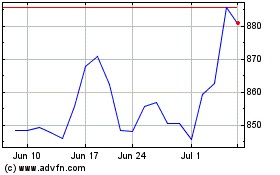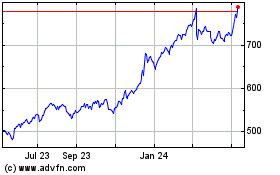Costco Sales Rise - Analyst Blog
July 06 2012 - 9:15AM
Zacks
Costco Wholesale
Corporation (COST), one of the leading U.S. warehouse club
operators, recently posted sales data for the five-week period
ended July 1, 2012. However, sales fell short of analysts’
expectations as unfavorable foreign currency fluctuations remained
a drag. Moreover, sales for the month were also marginally impacted
by deflation in gasoline prices.
After a 4% increase in May,
Costco’s comparable-store sales for June climbed 3%, reflecting
comparable sales growth of 3% at its U.S. locations and 2% at its
international divisions. In the prior-year period, the company
delivered comparable-store sales growth of 14%.
For the 44-week period ended July
1, 2012, the company registered comparable-store sales growth of
7%, with U.S. and international sales also rising by the same
percentage.
Excluding the effects of gasoline
prices and foreign currency fluctuations, Costco’s comparable-store
sales for June climbed 5%, with U.S. and international comparable
sales increasing 3% and 8%, respectively. For the 44-week period,
the company registered comparable-store sales growth of 6%, with
U.S. sales rising 6% and international sales climbing 9%.
Total net sales for June jumped 6%
to $9.18 billion from $8.69 billion in the same month last year.
For the 44-week period, sales increased 10% to $80.46 billion from
$73.44 billion in the same period last year.
Costco continues to be a dominant
retail wholesaler based on the breadth and quality of the
merchandises it offers. The company’s strategy to sell products at
heavily discounted prices has helped it to sustain growth amidst
beleaguered economic conditions, as cash-strapped customers
continue to reckon Costco as a viable option for low-cost
necessities. Having delivered consistent comparable-store sales
growth, Costco is well positioned in the warehouse club
industry.
A differentiated product range
enables Costco to provide an upscale shopping experience to its
members, resulting in market share gains and higher sales per
square foot. Moreover, the company continues to maintain a healthy
membership renewal rate. Costco also remains committed to open new
clubs in domestic and international markets. The company’s
diversification strategy is a natural hedge against risks that may
arise in specific markets.
However, Costco faces stiff
competition from Target Corporation (TGT) and
Sam’s Club, a division of Wal-Mart Stores
Inc. (WMT), which follows a similar business model that
pushes through high volumes of merchandise at low prices in
membership-only warehouse clubs. Thus, aggressive pricing to gain
market share and drive traffic amid stiff competition may depress
sales and margins.
Costco currently operates 605
warehouses, which include 438 in the United States and Puerto Rico,
82 in Canada, 32 in Mexico, 22 in the United Kingdom, 13 in Japan,
8 in Taiwan, 7 in Korea and 3 in Australia.
Going by the pulse of the economy,
we believe that budget-constrained consumers will remain watchful
on their spending and look for discounts. Consequently, we could
see more competitive pricing, compelling products and innovative
ways to attract shoppers.
Currently, we maintain our
long-term “Neutral” recommendation on the stock. However, Costco
holds a Zacks #3 Rank that translates into a short-term ‘Hold’
rating.
COSTCO WHOLE CP (COST): Free Stock Analysis Report
TARGET CORP (TGT): Free Stock Analysis Report
WAL-MART STORES (WMT): Free Stock Analysis Report
To read this article on Zacks.com click here.
Zacks Investment Research
Costco Wholesale (NASDAQ:COST)
Historical Stock Chart
From Mar 2024 to Apr 2024

Costco Wholesale (NASDAQ:COST)
Historical Stock Chart
From Apr 2023 to Apr 2024
